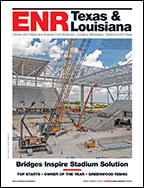Workers are building the $810-million Olympic Stadium with 80,000 seats and a partial roof. But in 2012, soon after officials of London Games hang the final medals around the necks of the winning athletes, crews will move back in to shrink the venue down to its "legacy mode," with only 25,000 seats and no roof. Consequently, from the start of design, a "here today, two-thirds gone tomorrow" attitude dominated the team's thinking.
The project marks “a new era of Olympic stadium design...demonstrating how a successful event can be blended with the long term needs of a community,” claims Rod Sheard, principal architect with stadium architect, Populous Ltd., London.
After the games, crews will remove everything above the lower seating bowl. For easy dismantling, the engineer selected structural steel for all the temporary structure. Members bolted together and connections are easily accessible, says Glyn Trippick, project director with Buro Happold Ltd., London, the design-build team’s multidisciplinary engineer.
The stadium design was not fixed when Team Sir Robert McAlpine Consortium, led by Sir Robert McAlpine Ltd., Hemel Hempstead, U.K., signed its contract with the Olympic Development Authority (ODA). The design-build team considered a scheme with no roof. But computational fluid dynamics computer analysis showed that without a roof, field conditions would impede the athletes' performances.
Throughout the design, the focus was on how to deal with the building’s permanent use. “When you are looking at something of which more than two thirds is a temporary structure, what you think about is not operational energy. It’s all to do with embodied energy,” says Trippick.
To help economize on materials, the design was pared down. “You give everybody a reasonable sight line, not the absolutely best,” says Trippick.
Containing 10,700 tonne of structural steel, the structure’s carbon footprint is substantially smaller than Beijing’s "Bird Nest" stadium for the 2008 Olympics. Some 42,000 tonne of steel went into that stadium, according to its supplier, Sulong Steel Pipe Co. Ltd., Jiangsu, China.
There was no possibility of saving on weight by using short-term design loads. The 100-year load condition could happen next year, says Trippick.
Raking steel trusses roughly 7 meters apart and up to 30 m long support the upper stand. Above it, the stadium's polyvinyl chloride-coated woven-polyester cover, which shelters two-thirds of the seat, is supported by a lightweight cable structure that projects 28 m from the stadium's perimeter.
The roof, a ring in plan, has an outer perimeter compression truss linked by cables to a tension ring around the roof's inside rim. Roof cables pull against backward-leaning 66-centimeter-dia steel tube columns just outside the stadium's perimeter, which are hinged at ground level supports. Column tops are linked by a compression truss around the perimeter, formed by three tube section chords: one lower and two upper. Unused pipeline steel was used for the 1.1-m-dia and 91-cm-dia chords after material testing, says Trippick.
The roof's 28 main radials are 7 cm in diameter and 32 m long. The tension ring contains 10 cables, each 6 cm in diameter.
The concrete lower bowl sits on piles bored through gravel and chalk. The roof and bowl are independent of each other. This avoids problems arising from the differential thermal movement between the lightweight cable roof and the solid bowl below, says Trippick.
ODA and Balfour Beatty declined to comment on construction of the roof frame, carried out by U.K. steel erector Watson Structural Steel Ltd., Bolton. Trippick says the "trickiest" part of the whole operation was the erection of the light towers that sit on the tension ring.
In part thanks to a heated market, the McAlpine consortium was the only final bidder for the stadium. To allay fears about negotiating a contract with a single entity, David Higgins, ODA's chief executive, at the time, said, “We have robust contingency plans in place should negotiations...not conclude.”
Those plans never needed testing. The parties signed the contract and the consortium completed most of the design work by the end of 2007.









Post a comment to this article
Report Abusive Comment